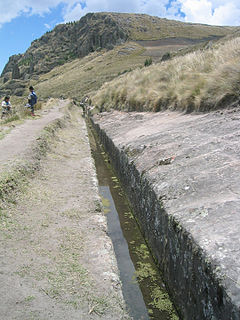 W
WEl Abra is the name given to an extensive archeological site, located in the valley of the same name. El Abra is situated in the east of the municipality Zipaquirá extending to the westernmost part of Tocancipá in the department of Cundinamarca, Colombia. The several hundred metres long series of rock shelters is in the north of the Bogotá savanna on the Altiplano Cundiboyacense, Eastern Ranges of the Colombian Andes at an altitude of 2,570 metres (8,430 ft). The rock shelter and cave system is one of the first evidences of human settlement in the Americas, dated at 12,400 ± 160 years BP. The site was used by the hunter-gatherers of the Late Pleistocene epoch.
 W
WNemocón is a municipality and town of Colombia in the Central Savanna Province, part of the department of Cundinamarca. Nemocón, famous for its salt mine, was an important village in the Muisca Confederation, the country in the central Colombian Andes before the arrival of the Spanish. The municipality is situated in the northern part of the Bogotá savanna, part of the Altiplano Cundiboyacense with its urban centre at an altitude of 2,585 metres (8,481 ft) and 65 kilometres (40 mi) from the capital Bogotá. Nemocón is the northeasternmost municipality of the Metropolitan Area of Bogotá and the Bogotá River originates close to Nemocón. The median temperature of Nemocón is 12.8 °C. The municipality borders Tausa in the north, Suesca and Gachancipá in the east, Tocancipá and Zipaquirá in the south and in the west the rivers Checua and Neusa and the municipality of Cogua.
 W
WCumbemayo or Cumbe Mayo is an archaeological site located 20 kilometers southwest of the city of Cajamarca in Peru at 3,500 meters of elevation. Built around 1500 B.C.E, it comprises aqueducts, a grotto and petroglyphs; all within an area of rock formations.
 W
WHato Caves are show caves, publicly accessible since 1991 and a popular tourist attraction on the Caribbean island of Curaçao. The caves consist of marine coral limestone, which accumulated over millions of years and after sea levels had dropped were exposed to atmospheric corrosion and karstic processes. They are approximately 240 m (790 ft) long and cover an area of 4,900 m2 (53,000 sq ft).
 W
WPiedras del Tunjo is an important archaeological park established on a natural rock shelter 40 kilometres (25 mi) west of Bogotá in the municipality of Facatativá.
 W
WQillqatani is an archaeological site in Peru. It is located above the Rio Chila, in the Puno Region, El Collao Province, Santa Rosa District, at a height of about 5 m (16 ft) above the riverbed. Qillqatani is surrounded by dry puna.
 W
WWerehpai is an archaeological site in Suriname consisting of several caves containing petroglyphs of pre-Columbian origin. The site is located about 10 kilometres (6.2 mi) from the village of Kwamalasamutu. With 313 identified petroglyphs, Werehpai is by far the largest pre-Columbian petroglyph site known in Suriname, and perhaps the largest in all of the Guianas.